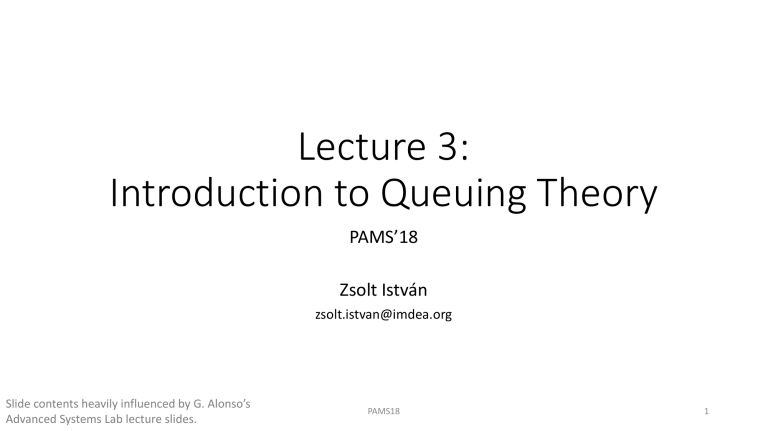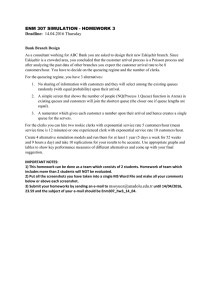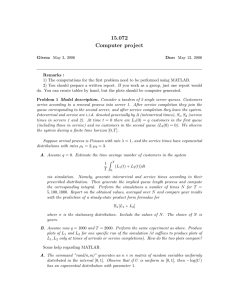
Lecture 3: Introduction to Queuing Theory PAMS’18 Zsolt István zsolt.istvan@imdea.org Slide contents heavily influenced by G. Alonso’s Advanced Systems Lab lecture slides. PAMS18 1 What is a queuing system? • Jobs arriving to a queue • One/multiple servers dealing with the jobs from the queue • When modeling queuing systems, it is important to talk about their properties • Some rules apply to all systems PAMS18 2 3 Properties of queuing systems 1. What is the arrival rate? 2. What is the service time? 3. What is the service discipline? 4. What is the system capacity? 5. What is the number of servers? 6. What is the population size? PAMS18 Interarrival time • τ1..N : Independent and Identically Distributed random variables • Events come from a “process”, Often assumed to be Poisson: • (1) the event is something that can be counted in whole numbers • (2) occurrences are independent, so that one occurrence neither diminishes nor increases the chance of another • (3) the average frequency of occurrence for the time period in question is known • (4) it is possible to count how many events have occurred, but we are not interested in how many have not occurred PAMS18 4 Mean Arrival rate • Interarrival time τ is a random variable • Mean value: E[τ] • Mean arrival rate: λ = 1/E[τ] • Does it look similar to something we discussed previously? • Useful to assume fixed λ for modeling • Do real systems have fixed λ? • Examples: • A new pizza order is received on average every 3 minutes. The arrival rate is 20/hour. • The printer receives a new job to print on average every 100ms, the arrival rate is 10jobs/second. PAMS18 5 Service time • Time to process a job (“useful work”, no queueing) • Random variable: s • Mean service rate μ = 1 / E[s] • What if we have m servers? • Not a random variable • Example: pizza oven bakes pizza on average in 6 minutes. μ = 10/hour PAMS18 6 A word on throughput • The service rate of a system is rarely the measured throughput! • Throughput is client and workload dependent • Throughput only counts successful operations • Is arrival rate the same as throughput? • In open systems? • In closed systems? • If there are no failed jobs? PAMS18 7 Default assumptions for other properties • What is the service discipline? • First come, first served (FIFO) • What is the system capacity? • Large enough buffers → Infinite buffers • What is the population size? • Very large → Infinite size PAMS18 8 Equations valid for all queueing systems • Load on system (traffic intensity): ρ = λ/(mμ) • Stability condition: ρ < 1 because this meant that λ < (mμ) • What if ρ = 1? Can the system still be considered stable? • Remember arrival time is a random variable! • Once queueing starts, it never empties… PAMS18 9 Traffic intensity example • A USB thumb drive is serving 5k I/O ops/s • The average time spent on the I/O operation is 0.1ms • What is its utilization? • ρ = λ/(mμ) • ρ = 5k / (μ) • μ = 1/0.1 = 10k • ρ = 5k / 10k = 0.5 (50%) PAMS18 10 More detailed metrics • Number of jobs in the system is the sum of the jobs in the queue and the ones in service • n = ns + nq • Total time spent in system (response time) is the sum of time spent queuing and that in service • r = wq + s • Remember these are random variables, we’ll speak of their expected value. PAMS18 11 Little’s law • Remember: n = ns + nq • The system as a whole: E[n] = λ * E[r] • Only the queue part: E[nq] = λ * E[wq] • E[ns] = λ * E[s] – looks familiar? • If m=1 and E[ns]=1, the system is unstable! • ρ = λ/(mμ) → ρ = E[ns] /m PAMS18 12 Quick overview of M/M/1 queues • Interarrival times and service times Poisson • Single server • FIFO processing • Parameters: • Mean arrival rate • Mean service rate • Please look at the book for more detail and explanations. Have a look at the list of formulas. PAMS18 13 Response time in M/M/1 • The mean number of jobs in the system is computed using the probabilities of having 0..infinity jobs in the system. • Using Little’s law (E[n] = λ * E[r]), we get • E[r] = ρ/(λ *(1-ρ)) = (μ * (1- ρ))-1 PAMS18 14 Quick overview of M/M/m queues • • • • Interarrival times and service times Poisson Single server FIFO processing m parallel servers (no queueing if the number of jobs <= m) • Parameters: • Mean arrival rate • Mean service rate • Server parallelism • Please look at the book for more detail and explanations. Have a look at the list of formulas. PAMS18 15 All formulas for M/M/1 and M/M/m PAMS18 16 Exercise • μ = 250/s • E[s] = ? • λ = 1200/s • What is better for clients? 5x M/M/1 or 1x M/M/m? • For M/M/1: E[r] = 0.1s • For M/M/m: E[r] = 0.022s • The jobs wait in a single queue and can go to any available server. In the other case they need to wait for their pre-chosen server to become available… Hint: there are many tools/websites that help with computing the outputs of the models (e.g., https://www.supositorio.com/rcalc/rcalclite.htm) PAMS18 17 Network of queues • A collection of queue/server pairs • Jobs “flow” through the network • Can represent arbitrarily complex systems • Open and closed variants PAMS18 18 Properties of NoQ devices • Service discipline • FIFO (e.g., M/M/1 and M/M/m) • Delay center (imagine M/M/∞) • … • Job classes • All jobs are equal • Job flow balance • Number of arrivals at each device equals number of leaving jobs • One-step behavior • The state of the network changes only as a result of a job entering the system (a device) PAMS18 19 Operational laws • Valid for all devices • • • • Arrival rate λi = (number of arrivals)/time = Ai/T Throughput Xi = (number of completions)/time = Ci/T Utilization Ui = (busy time)/time = Bi/T Mean service time = (busy time)/(number of completions) = Bi/Ci • Utilization Law • Ui=Bi/T = Ci/T * Bi/Ci • Ui=Xi * Si (Device with highest utilization is the bottleneck device) • Forced flow law • Ai = Ci • System throughput X = (jobs completed)/time • Device throughput Xi = X * Vi • Vi is the visit ratio; how many times a job is handled by the device i PAMS18 20 Mean Value Analysis (MVA) • Algorithm to compute the behavior of a NoQ with increasing clients • Might have to map throughput levels to number of clients! Throughput [job/s] 200 MVA 150 Measurement 100 50 0 0 50 100 Clients PAMS18 21



